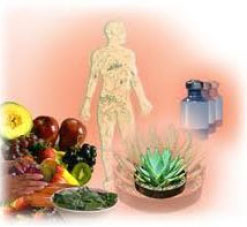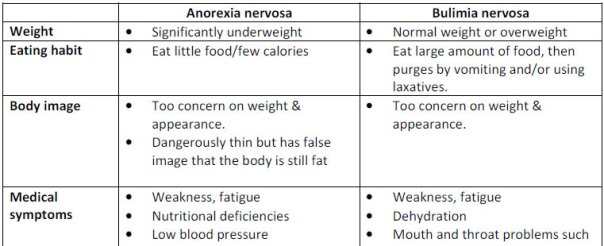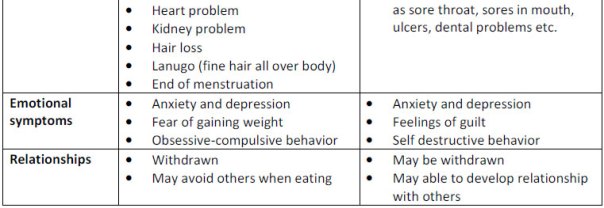Blog Archives
Eating Disorders- Anorexia Nervosa and Bulimia Nervosa
An eating disorder is an illness that causes serious disturbances to your everyday diet, such as eating extremely small amounts of food or severely overeating. Someone with an eating disorder can appear very thin, healthy weighted or above healthy weight. It frequently appears during the teen years or young adulthood but may also develop during childhood or later in life. Eating disorders can become life-threatening if a person does not receive treatment.
Anorexia nervosa is an eating disorder that makes people lose more weight than is considered healthy for their age and height. People with this disorder may have an intense fear of weight gain, even when they are underweight.
Bulimia nervosa is an eating disorder in which a person binges and purges. The person may eat a lot of food at once and then try to get rid of the food by vomiting, using laxatives, or sometimes overexercising.
Anorexia Nervosa vs. Bulimia Nervosa
Prevalence in Malaysia
- In Malaysia, there is no any concrete studies/ systematic research on the prevalence of eating disorders.
- Estimated figure is 1% of the population having anorexia nervosa, 3% having bulimia nervosa.
- For every 10-20 females with eating disorders, there would be one male with similar problem.
- Anorexia nervosa usually occurs in early adolescence, about 14 years old. Bulimia nervosa happens slightly later but still within the young adult population.
Possible Causes and Risk Factors
Being female
Teenage girls and young women are more likely than are teenage boys and young men to have eating disorders.
Age
Eating disorders are more common during the teens and early 20s compared with lesser cases at other life stages.
Family history
Eating disorders more likely to occur in people who have parents or siblings with history of an eating disorder.
Emotional disorders
People with depression, obsessive-compulsive disorder, anxiety disorders, and/or had any transitions that cause emotional distress (joined college, new job or a relationship breakup) may have eating disorders.
Dieting
Eating disorders may occur in people who take up dieting to improve their appearance.
Eating disorders may occur in people whose job/activities favors a slim
body
Work – athletes, actors, television personalities, dancers, models. Sports –ballerinas, gymnasts, runners and wrestlers.
Society
Peer pressure and media influence may fuel the desire to be thin, particularly among young girls. Western cultural environment often cultivates a desire for thinness.
 Treatments and Recovery
Treatments and Recovery
If you suspect yourself or someone else having eating disorder(s), get it treated immediately before
it’s too late. You may see both a medical doctor and a mental health doctor for a diagnosis. They may
do various assessments such as physical exams, laboratory tests (blood and urine) and psychological
(mental health) evaluations to pinpoint a diagnosis.
Medical treatment and drugs
- Psychotherapy is an education which helps to develop healthy habits, problem–solving skills, stress handling skills. It also helps to improve relationships and mood. Family-based therapy may also be considered.
- Nutrition educations in which dietitians can help you achieve a healthy weight and instill normal-eating habits.
- Medication which may helps to control urges to binge or purge or to manage excessive preoccupations with food and diet. Antidepressants and anti-anxiety medications may also help with symptoms of depression or anxiety.
Lifestyle and home remedies
- Practicing proper self-care during and after treatment as per doctor’s advice is crucial to maintain overall health.
- Appropriate vitamin and mineral supplements is essential for a healthier body.
Alternative medicine
Several treatments that help to improve mood, lower stress and reduce anxiety include:
- Chamomile tea
- Acupuncture
- Massage
- Yoga
- Biofeedback
Prevention
For yourself
- Be realistic. The ultra thin models or actresses in popular magazines aren’t healthy bodies.
- Surround yourself with positive influences and be a positive influence yourself.
- Don’t visit websites that advocate or glorify eating disorders.
- Communicate with your friends and family.
- Learn about
For your children, relatives and friends
Encourage healthy-eating habits and avoid dieting around your children.
Family dining habits influence the relationships children develop with food. Eating meals together gives an opportunity to teach children about the pitfalls of dieting, and encourage healthy eating.
Keep an eye on computer use.
There are numerous websites that promote anorexia (commonly called “pro-ana” sites) as a lifestyle. Periodically check the computer’s history page to see what sites your child has visited.
Cultivate and reinforce a healthy body image
Talk to children about their self-image and offer reassurance that body shapes can vary. Encourage children or family members to refrain from joking about others body size.
Reach out if you suspect trouble.
If you notice a family member or friend with low self-esteem, severe dieting, frequent overeating, hoarding of food or dissatisfaction with appearance, consider talking to him or her about these issues. Reaching out with compassion may encourage him or her to recover or seek treatment.
Where to go?
- Malaysia Eating Disorders Therapists provide counselling services by psychiatrists, psychologists, nutritionists and therapists to facilitate rehabilitation.
- Malaysian Mental Health Association Support Group for people who have/had an eating disorder and their caregivers. They meet monthly to share stories and support each other.
March Topic : Food Handling
Topic of the Week : Safe Food Handling and Food Borne Diseases
Food borne diseases are a widespread and growing public health problem, both in developed and developing countries. Food borne diseases are usually either infectious or toxic in nature, caused by agents that enter the body through the ingestion of food. Every person is at risk of food borne diseases.
Thousands of types of bacteria are naturally present in our environment. Not all bacteria cause disease in humans. For example, some bacteria are used beneficially in making cheese and yogurt. Bacteria that cause disease are called pathogens.
- Prevalence
The global incidence of food borne disease is difficult to estimate, but it has been reported that in 2005 alone 1.8 million people died from diarrhea diseases. A great proportion of these cases can be attributed to contamination of food and drinking water.
Despite many actions taken by government or private sectors to improve sanitation and hygiene, however, incidence rate of cholera, dysentery, typhoid and Hepatitis A are in increasing mode in Malaysia, as compared between Health Facts 2008 and 2009.
- Common pathogens that lead to food borne diseases
| Pathogens | Food Source |
| Salmonella | Raw and undercooked eggs, undercooked poultry and meat, dairy products, seafood, fruits and vegetables. |
| Campylobacter | Raw and undercooked meat and poultry, raw milk and untreated water. |
| Escherichia coli | Raw or undercooked meat and raw milk. |
| Cholera | Untreated water |
- Common symptoms of food borne diseases:
– Diarrhea
– Vomiting
– Nausea
– Abdominal cramps
– Fever
– Joint/back aches
– Fatigue
- How will I know if my symptoms are a result of food borne illness?
It can be difficult to know if your symptoms are due to food borne illness or to another cause. Some of the foods borne symptoms are headache, fever and vomiting, which can be attributed to the flu or other illnesses. A healthcare practitioner may be able to determine the cause of your symptoms.
In all cases of illness, regardless of the cause, it is important to seek immediate medical attention when food borne symptoms are severe.
- Four Easy Steps of Safe Food Handling
1. Wash hands and surfaces often
Hands need to be washed under running water for 20 seconds after and before touching foods.
2. Separate: Don’t cross-contaminate
Use a different cutting board for raw meats, salads and ready to eat foods. Cross-contamination occurs when meats, poultry and seafood come in contact with ready to eat foods or foods that do not required cooking.
3. Cook to proper temperatures
Make sure foods are thoroughly cooked (no cool spots) and use a meat thermometer to measure internal temperature.
4. Chill-Refrigerate promptly
The danger zone for rapid growth of bacteria is between 40 – 120. Most of harmful bacteria do not multiply at temperature below than 40
- Storage tips for eggs
The best way to store eggs is to keep them in their own carton in the fridge. Egg shells are porous and can become tainted by strong-smelling foods in your fridge.
Keeping them in the carton makes this less likely to happen. Don’t wash eggs as the shell becomes more porous when wet, making it easier for bacteria to get in.
- 2-hour Rule
Refrigerate or freeze perishables, prepared food and leftovers within 2 hours to avoid bacteria grow to unsafe level. Do not leave them sitting out at room temperature.
- Storage tips for potatoes
Store raw potatoes in a dark place. Potatoes exposed to light will produce solanine, which turns potatoes into green colour. Cut away and discard any green spots before cooking because solanine tastes bitter and can also cause indigestion if eaten in large amounts.
Store potatoes separately. Do not store potatoes with apples, pears, bananas, or onions. These vegetables will cause potatoes to spoil more quickly and may also transfer flavors.
Everyone Plays a Role in Food Safety
Food contamination can occur at any stage from farm to table. Everyone on the food delivery chain must employ measures to keep food safe – farmer, processor, vendor and consumer. Safety at home is just as vital to prevent disease outbreaks. Women are primary targets for food safety education as they are responsible for household meals in many societies.
Article courtesy of Golden Horses Health Sanctuary.
Download this article here.






